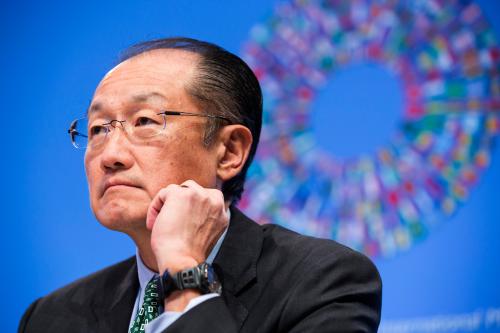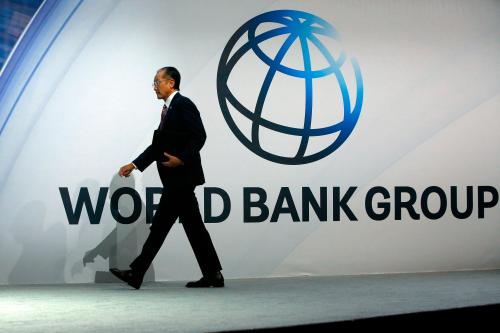During the International Monetary Fund and World Bank Spring Meetings in April, the joint ministerial-level Development Committee reached an agreement on a proposal for a significant capital increase to be approved by the World Bank Group’s (WBG) member countries at the bank’s annual meeting in October 2018. The agreement includes a capital increase of $7.5 billion paid-in capital and of $52.6 billion callable capital for the International Bank for Reconstruction and Development (IBRD), the WBG’s lending window for middle-income countries, and a $5.5 billion paid-in capital increase for the International Finance Corporation (IFC), the WBG’s private sector window.
In addition to the December 2017 funding potential of the International Development Association (IDA), the WBG’s window for the low-income countries, these increases represent a substantial and much-needed strengthening of the WBG’s financial capacity and an expression of confidence by the membership in the World Bank. Without the capital increase, the potential for IBRD and IFC financing would have been severely limited in the coming years. With the capital increase, according to the World Bank’s management, annual WBG financing can grow from about $60 billion now to about $100 billion in 2030. Moreover, a temporary expansion of IBRD lending will be possible in case of a global financial crisis. The agreement, along with the new IDA funding approach and IDA’s success in accessing the capital markets, is a major achievement.
The agreement is based on a careful balancing of diverging interests among the WBG members. The Trump administration had previously expressed strong reservations about the World Bank’s lending to upper middle-income countries, in particular China, and more generally has shown a lack of support for multilateral institutions. U.S. endorsement of the capital increase therefore came as a surprise to many observers. The U.S.—along with some other G-7 members—made their support conditional on a number of reforms in the WBG business model. Key objectives of these reforms, according to the statement of the U.S. governor of the WBG at the April 2018 Development Committee Meeting, are to shift lending to the poorer WBG clients, through a new income-based lending allocation target, the re-introduction of differentiated pricing, and a more aggressive approach to graduation of upper middle-income countries, along with various efficiency enhancing and cost-saving measures. Other G-7 shareholders (e.g., the United Kingdom) also supported a greater focus on the poorest and most fragile countries.
But the document underpinning the agreement and endorsed by the Development Committee also states that the WBG will continue serving all its clients and graduation from WBG financing will remain governed by its existing policy (which makes graduation a consultative and voluntary process), albeit with a more systematic application of this policy. The document also endorses strengthening the WBG’s support for global public goods and offering enhanced support to member countries during times of financial crisis. This responds to the interests of middle-income members of the World Bank and of those that want to see the institution effectively address important global challenges.
Thus the agreement on the WBG’s capital increase masterfully bridges the tension between two visions for bank: First, there are those who see the future of the institution as a “Bank for the World’s Poor,” i.e., an institution providing aid to its weakest clients as part of the broader architecture of development aid, and eventually working itself out of a job and out of existence once the poverty problem is successfully tackled. This was the underlying premise of the “Meltzer Report” of 2000, prepared for a U.S. congressional commission on the international financial institutions. And then there are those, myself included, who would like to see a “Bank for the World,” i.e., a credit union of all its members, which, in principle, could assist all its members in dealing with growing global challenges. The latter approach would follow the example of two other multilateral finance institutions, the European Investment Bank (EIB) and the Development Bank of Latin America (also known as Corporacion Andina de Fomento, or CAF), which are principally focused as credit unions for all their members.
This tension among fundamental goals is not new for the bank: The IBRD’s Articles of Agreement focus on reconstruction, development, investment, trade, and productivity as the World Bank’s purpose. Poverty is not mentioned. Later, former World Bank President Robert McNamara placed poverty reduction at the center of the WBG’s mission in a speech in Nairobi in 1973, where he defined the poor as the lowest 40 percent of the population. The World Bank’s focus on poverty reduction was reinforced by President James Wolfensohn (1995-2004) and further by current President Jim Kim when he postulated in 2013 the “twin goals”: eliminating extreme poverty by 2030, and promoting income growth of the bottom 40 percent (aligned with McNamara’s earlier definition of poverty).
At the same time, the World Bank remained fully engaged in middle-income countries, recently provided advisory assistance to selected high-income countries, such as Greece, and over the past two decades substantially invested in global public goods.
The agreement on the capital increase masterfully bridges the tensions among different visions for the WBG and allows it to face the immediate future with renewed strength and confidence of its members. One can hope—based on its interim “update” report of March 2018—that the G-20 Eminent Persons Group on Global Financial Governance, which is to set out directions of the international financial institutions, including the WBG, will build on this foundation and point the World Bank in a direction that allows it to deliver on what I believe is its fundamental mandate, namely to assure inclusive and sustainable growth worldwide.
The internationally agreed Sustainable Development Goals (SDGs) have highlighted poverty and hunger as key global challenges, and the WBG must clearly address these. However, poverty and hunger are by no means the only global challenges, and—if the SDGs are successfully reached—they will hopefully decline in importance in the coming decade.
At the same time, the world faces many other problems, some of them growing in severity, including climate change, epidemics, economic instability, and political conflict. Moreover, there are global infrastructure investment needs, as well as global education, skills development, health, and employment challenges, which—while they may differ across countries—affect all of the World Bank’s members. The WBG has a special, and I believe growing, role to play in addressing these global challenges, consistent with its Articles of Agreement, potentially in all its member countries. As the World Bank’s recent long-term vision document (“Forward Look”) cogently demonstrates, the WBG as the only truly global multilateral finance institution uniquely combines global reach, the ability to leverage and bundle finance, knowledge and convening power, and the capacity for crowding in the private sector. It is therefore the obvious institution to support its member countries in taking on the broad array of global challenges, rather than fading away as the world’s poverty challenge is gradually reduced.







Commentary
Will a capital increase mean a greater global role for the World Bank?
May 14, 2018